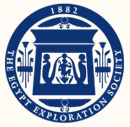Egypt Exploration Society
British non-profit archeological organization From Wikipedia, the free encyclopedia
British non-profit archeological organization From Wikipedia, the free encyclopedia
The Egypt Exploration Society (EES) is a British non-profit organization. The society was founded in 1882 by Amelia Edwards and Reginald Stuart Poole in order to examine and excavate in the areas of Egypt and Sudan. The intent was to study and analyze the results of the excavations and publish the information for the scholarly world.[1]
 The logo of the Egypt Exploration Society | |
| Abbreviation | EES |
|---|---|
| Established | 1882 |
| Founders | Amelia Edwards and Reginald Stuart Poole |
| Type | Nonprofit |
| Legal status | Charity |
President | Prof Alan B. Lloyd |
Chair | Dr Campbell Price |
Director | Dr Carl Graves |
Staff | 6 |
| Website | ees.ac.uk |
Formerly called | Egypt Excavation Fund (1882–1919) |
The organization has worked at many major Egyptian excavation and sites. Their discoveries include the discovery of a shrine for the goddess Hathor, a statue of a cow from Deir el-Bahri, the mortuary temple of Queen Hatshepsut, and the sculpted model of Nefertiti from Amarna. The organization has made major contributions to the study of the ancient Egyptian world.[2] It is based in London and is a registered charity under English law.[3]

In 1873, the English writer Amelia Edwards was led to the sites of Egypt while encountering cold, wet climates in Europe. She and several friends ended up travelling up the Nile River from Cairo to Abu Simbel. She recorded the events and discoveries of this journey and eventually published it as A Thousand Miles up the Nile in 1876. The book became renowned for its description of 19th-century Egypt and the largely un-excavated antiques that she encountered. Edwards' descriptions changed the world's perspective on both modern and ancient Egypt. This attracted the attention of both scholarly society and the rest of the world. It ended up becoming a bestseller due to this increased interest, which prompted Edwards to think about continuing her studies of ancient Egypt.
In 1882, Amelia Edwards and Reginald Stuart Poole, an employee from the Department of Coins and Medals at the British Museum, decided to create the Egypt Exploration Fund as a way to raise funds for more excavations in the Nile Delta, which had been noted as being rarely visited.[1] After announcing their intentions in The Times, they started off being funded by individuals such as the Archbishop of Canterbury, the poet Robert Browning, and Sir Erasmus Wilson. Wilson, in particular, showed enough interest to pledge £500 to the Egypt Exploration Fund. This marked the start of the Egypt Exploration Society.[2]
The first excavator of the Egypt Exploration Fund was Édouard Naville, a Swiss Egyptologist and Biblical scholar. In January 1883, Naville set out for Tell el-Maskhuta. His goal was to find the route of the Biblical exodus as the Fund had decided to broaden its interests in order to appeal to a wider audience. Naville's work attracted much interest from the public and at the first General Meeting of the Fund, which happened on 3 July 1883, the society was seen to have a good amount of funds in its accounts. A copy of Naville's work was distributed to the subscribers of the Fund. Eventually the Fund decided to have the subscribers become members instead.[2]
During the second excavation, the Fund sent Flinders Petrie, an English Egyptologist, who went to Tanis, a site linked to the Biblical city of Zoan. Petrie focussed much of his work on the ordinary dwellings of the site. This presented a new array of discoveries for the society. Petrie was among the first to understand that there was more than æsthetically appealing objects. Rather, he understood that many objects could provide information about the society of that time. He developed many techniques in which he could excavate and record the objects he found and his overall findings. At the end of his excavation, Petrie was able to bring back many valuable findings and items that he donated to the British Museum. The society became one of the first to provide scientifically excavated objects around Britain as well as overseas.[2][4]
By the time of the third excavation, and the third year since the Fund was established, the society was able to send Edouard Naville, Flinders Petrie and Francis Llewellyn Griffith to Egypt. During this time and for the next few years, the Fund was able to bring back many findings, which resulted in the advancement of knowledge on ancient Egypt. Some of the sites included the fortified camp and Tell Dafana and the temple of Bastet.[2]
In 1919, at the end of World War I, the Egypt Exploration Fund changed its name to the Egypt Exploration Society.[5]
Today, the EES continues to publish its annual organ, the Journal of Egyptian Archaeology, which details the society's findings, for all of its members to read.[6] They also publish a newsletter bi-annually called Egyptian Archaeology.[7] The Egypt Exploration Society has been based in Doughty Mews, London WC1N since 1969.[8]
In October 2019 officials from the Egypt Exploration Society alleged that Oxford professor, Dirk Obbink, engaged in the theft and sale of "at least 11 ancient Bible fragments to the Green family, the Hobby Lobby owners who operate a Bible museum and charitable organization in Washington." The Museum of the Bible said it will return the fragments to the Egypt Exploration Society and Oxford University.[9]
Seamless Wikipedia browsing. On steroids.
Every time you click a link to Wikipedia, Wiktionary or Wikiquote in your browser's search results, it will show the modern Wikiwand interface.
Wikiwand extension is a five stars, simple, with minimum permission required to keep your browsing private, safe and transparent.